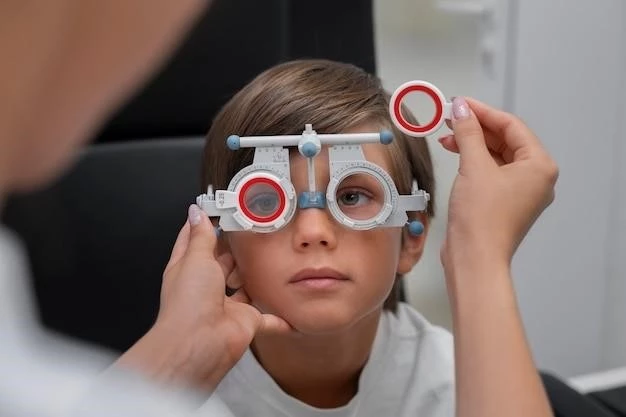Introduction
Quadrantanopia, or quadrantanopsia, is a visual condition characterized by a loss of vision in a quarter of the visual field․ It can result from various brain lesions, providing valuable information on cortical damage;
Definition of Quadrantanopia
Quadrantanopia, also known as quadrantanopsia, is a visual impairment characterized by the loss of vision in one quarter of the visual field․ This condition can occur due to various lesions affecting the optic radiations, resulting in a specific pattern of visual field deficit․ Understanding quadrantanopia is crucial in diagnosing and localizing brain lesions that lead to visual abnormalities․

Causes and Types
Quadrantanopia can result from brain lesions affecting the optic radiations or occipital lobe, leading to distinct patterns of visual field deficits․
Damage to Optic Radiations
Quadrantanopia can occur due to lesions affecting the optic radiations․ These lesions disrupt the transmission of visual information from the eyes to the brain, resulting in specific patterns of visual field deficits associated with the damaged pathways․
Lesions in the Occipital Lobe
Quadrantanopia can also be caused by lesions in the occipital lobe, leading to specific visual field deficits․ Damage to this area of the brain can result in distinct patterns of vision loss associated with the affected region․

Symptoms and Diagnosis
Visual field deficits are a common symptom of quadrantanopia, and diagnosis often involves detailed assessments of the visual fields using specialized tools like perimetry․ Brain imaging plays a crucial role in identifying underlying brain lesions․
Visual Field Deficits
Quadrantanopia presents as a unique visual field defect affecting one-quarter of the field of view, causing specific patterns of vision loss that can vary depending on the location of the brain lesion․ Understanding these visual field deficits is crucial in diagnosing and managing quadrantanopia effectively․
Role of Brain Imaging
Brain imaging techniques play a crucial role in diagnosing quadrantanopia by identifying the specific brain lesions responsible for visual field deficits․ Magnetic resonance imaging (MRI) and computed tomography (CT) scans are commonly used to visualize the brain structures and locate the areas affected by lesions causing quadrantanopia․
Case Study
A 60-year-old man experienced sudden onset homonymous quadrantanopia, affecting the upper left quadrant of his visual field․ Brain imaging revealed a lesion in the right occipital lobe, leading to this rare visual condition․
Sudden Onset Homonymous Quadrantanopia
Homonymous quadrantanopia is a rare visual impairment characterized by a sudden loss of vision in one quarter of the visual field, often associated with brain lesions affecting the occipital lobe․ Rapid onset of this condition can be alarming and may indicate underlying neurological issues that require immediate evaluation and intervention․
Cortical Blindness
Cortical blindness, also known as cerebral blindness, is characterized by the loss of vision due to bilateral lesions in the occipital lobes without ophthalmological causes․ This condition results in visual impairment despite normal pupil responses, requiring specific diagnostic approaches and management strategies․
Definition and Characteristics
Quadrantanopia refers to a specific visual field defect characterized by the loss of vision in a quarter section of the visual field․ This condition can be associated with lesions affecting different areas of the brain, leading to unique patterns of visual impairment that can impact an individual’s daily functioning and quality of life․ Understanding the characteristics of quadrantanopia is essential in diagnosing and managing this visual disorder effectively․
Evaluation and Management
Homonymous superior quadrantanopia, affecting the upper quadrant of both eyes, requires specialized evaluation and rehabilitation for visual field deficits․ The management includes strategies to optimize visual functioning and quality of life, emphasizing the role of rehabilitation in adapting to visual impairments effectively․
Homonymous Superior Quadrantanopia
Homonymous superior quadrantanopia is a specific type of visual field deficit that affects the upper quadrant of both eyes on the same side, typically resulting from damage to specific areas of the brain’s visual pathways․ This condition requires specialized evaluation and rehabilitation to address the visual impairment effectively․
Role of Rehabilitation
Rehabilitation plays a critical role in the management of homonymous quadrantanopia, focusing on optimizing visual functioning, adapting to visual impairments, and enhancing the individual’s quality of life․ Specialized rehabilitation programs aim to improve visual skills and promote independence in daily activities, recognizing the unique visual challenges associated with this condition․
Localization of Lesions
Posterior retrogeniculate pathway plays a critical role in localizing lesions causing quadrantanopia, such as in the occipital lobe․ Understanding the temporal vs․ parietal lobe damage aids in pinpointing the specific regions affected․
Posterior Retrogeniculate Pathway
The posterior retrogeniculate pathway plays a crucial role in localizing lesions associated with quadrantanopia by connecting the visual cortex to the occipital lobe․ Understanding this pathway aids in pinpointing the specific regions affected by brain lesions causing visual field deficits․
Temporal vs․ Parietal Lobe Damage
Quadrantanopia can result from damage to the temporal or parietal lobes of the brain, each causing distinct patterns of visual field deficits․ Lesions affecting the temporal lobe can lead to superior quadrantanopia, while damage to the parietal lobe may result in inferior quadrantanopia․ Understanding the differences in visual field deficits associated with these specific areas is crucial for accurate diagnosis and management of quadrantanopia․
Comparison with Hemianopia
Differentiating visual field defects like quadrantanopia from hemianopia is crucial in understanding the unique patterns of vision loss associated with specific brain lesions․
Differentiating Visual Field Defects
Distinguishing between visual field defects like quadrantanopia and hemianopia is essential for understanding the distinct patterns of vision loss associated with specific brain lesions․ Identifying these differences aids in accurate diagnosis and targeted management strategies for each condition․
Treatment and Prognosis
Management strategies for quadrantanopia focus on optimizing visual functioning and quality of life․ Understanding the outcomes and recovery potential is essential for providing effective care․
Management Strategies
Effective management of quadrantanopia involves optimizing visual functioning and quality of life․ Various rehabilitation approaches and assistive devices can help individuals adapt to visual field deficits and improve their overall visual skills, enhancing independence and daily activities․
Outcomes and Recovery
Understanding the outcomes and recovery potential for individuals with quadrantanopia is essential in providing appropriate care and support․ While the prognosis may vary depending on the underlying cause and extent of the visual field deficit, timely intervention and rehabilitation can help improve visual functioning and quality of life for affected individuals․
Association with Stroke
Occipital pole involvement in stroke can result in quadrantanopia, indicating an association between brain infarction and visual field deficits․ The relation to COVID-19 infection highlights the diverse etiology of this visual impairment․
Occipital Pole Involvement
Quadrantanopia is often associated with stroke, particularly involvement of the occipital pole․ This condition highlights the importance of recognizing the visual field deficits resulting from brain infarction, indicating a need for prompt evaluation and treatment․
Relation to COVID-19 Infection
Quadrantanopia linked to COVID-19 infection showcases the diverse etiology of this visual impairment․ Understanding this association can aid in early recognition and management of visual deficits in individuals recovering from COVID-19․
Prevention and Lifestyle Changes
Reducing risk factors associated with quadrantanopia and making necessary lifestyle changes can help in preventing its occurrence․
Reducing Risk Factors
Implementing preventive measures such as regular eye exams, blood pressure control, and healthy lifestyle habits can help reduce the risk of developing quadrantanopia․ Lifestyle changes like maintaining a balanced diet, staying active, and avoiding smoking can also contribute to overall eye health and reduce the likelihood of vision-related complications․
Future Research and Innovations
Advancements in understanding quadrantanopia are essential for improving diagnostic techniques and developing innovative treatment modalities in the field of visual impairment․
Advancements in Understanding Quadrantanopia
Continued research efforts aimed at deepening the understanding of quadrantanopia are essential for enhancing diagnostic capabilities and exploring innovative treatments․ By delving into the intricate mechanisms underlying this visual impairment, researchers can uncover new insights that may lead to improved management strategies and better outcomes for individuals affected by quadrantanopia․
